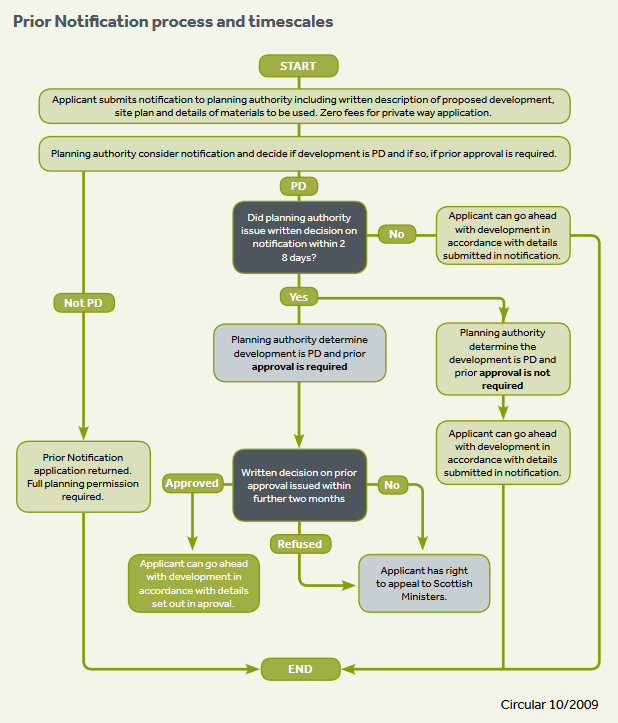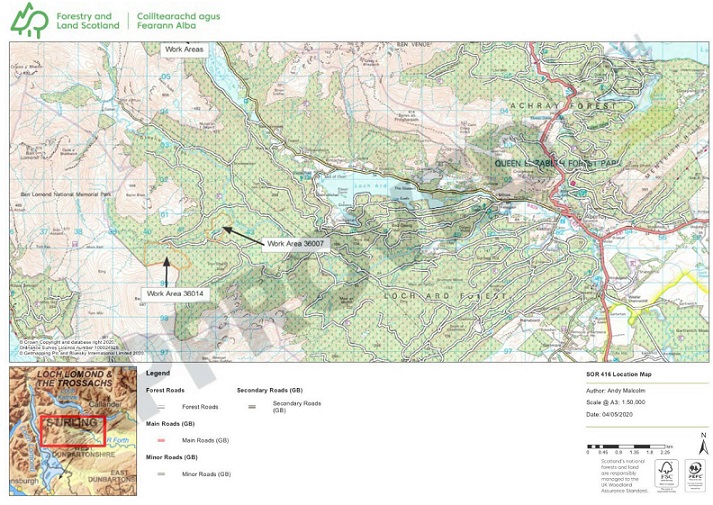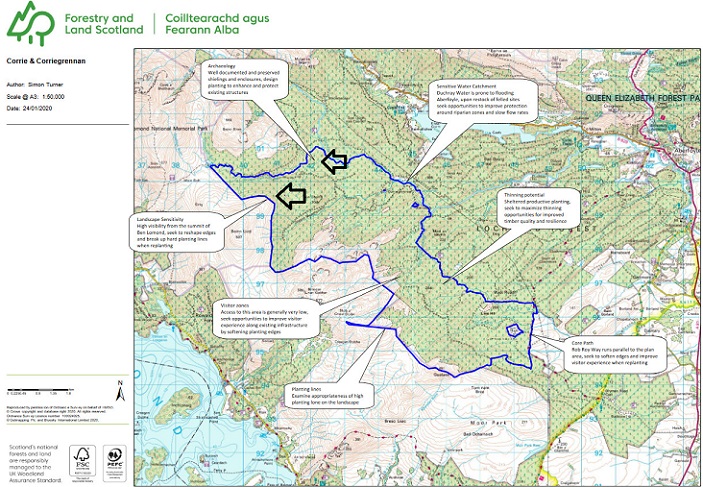Following my second post (see here) on the Inverardran forest road near Crianlarch, Mary Jack sent me a list of all the prior notifications for forest roads considered by Loch Lomond and Trossachs National Park Authority (LLTNPA) last year and their decision in each case. This post considers what that list (see here) tells us about the effectiveness of the Prior Notification system and the impact the LLTNPA is having on the way Forest and Land Scotland manages the land it owns on behalf of the public in the National Park.
The Prior Notification System
First, a brief explanation. Under Planning legislation forest roads are treated as permitted developments but in 2014 the Scottish Government introduced a requirement that all such roads must be notified to the Planning Authority before they are constructed, hence “Prior Notification”. The Planning Authority, even where it is a National Park, has no power to refuse a forest road, though it can challenge whether a road is really for forestry purposes. But the Planning Authority does have the power to influence the route and design by requiring the developer to seek “prior approval” within 28 days of being notified. That might, for example, involve the forest manager supplying further details about the proposed road, its impact and mitigation measures and the Planning Authority might then stipulate certain conditions before the forest road can be constructed. If the Forest Manager disagrees they can then appeal to the Scottish Government.

Overview of FLS Prior Notifications in 2020
Mary Jack’s list shows that FLS submitted 15 separate Prior Notifications for forest roads to the LLTNPA in 2020 and in just one of these cases did the LLTNPA require Prior Approval. By comparison, there were nine Forest Road applications from the private sector, three of which required full planning permission (if a Forest Road joins a public road it is not classed as a Permitted Development). Of the Prior Notifications from private forestry interests, two of the six required Prior Approval. In other words the LLTNPA only required FLS to seek Prior Approval in 6.66% of cases compared to 33.33% of private sector forestry cases.
This might not be significant IF FLS had agreed with the LLTNPA a detailed specification for forest roads, which set out how they would be constructed and where they might be appropriate. However, that is not the case. The LLTNPA’s Trees and Woodland Strategy, which it developed with Scottish Forestry the body that regulates the forestry industry, adopts the UK Forestry Standard. This says nothing about forest design in National Parks, let alone the roads within those forests (see here). Appendix 5 to the Strategy (see here) does set out how the LLTNPA and Forestry Scotland will co-operate in respect of the Prior Notification system, but includes no criteria for when Prior Approval of a road might be required. The LLTNPA’s focus appears to be entirely on speedy processes and not on determining whether a forest road is compatible with the statutory objectives of our National Parks.
This set-up – I hesitate to call it a system – leaves everything to the discretion of the staff involved. Then, since the LLTNPA doesn’t get paid planning fees for considering Prior Notifications, spending time considering the implications of new forest roads is not a management priority, whatever a member of staff’s personal views. That is wrong.
2020 was an unusual year because of the Covid restrictions but the LLTNPA nevertheless allowed FLS to go ahead with constructing a total of 16,490m or just over 10 miles of new forestry roads, mostly without comment. Even at this rate, that would be 100 miles of new road in 10 years. Forestry road development is transforming the landscape, ecology and access routes within the National Park but it appears no-one is taking an overview or has taken the responsibility for trying to decide whether this development is compatible with the LLTNPA statutory objectives or not.

Instead, there is an abdication of responsibility. This starts with the terminology used in the FLS Prior Notifications. The roads are variously described as “harvesting access track”, “Forest Road”, “temporary forest road”, “forwarder track” and most commonly “All Terrain Vehicle Access Tracks”. Nowhere is it explained what, if anything, is meant by these different terms or what the implications might be. For example, most, but not all, of the ATV access track applications appear to be initially for felling purposes. These should require a very different specification compared to a road used by quad bikes for deer management purposes. But apart from from stating whether the roads will be dug in situ or use imported material and, in some cases, that the intention is to narrow the road to quad bike width once felling is complete, its almost impossible to tell what is proposed and the potential longer term impact on landscape, access or ecology.
In some cases LLTNPA officers refer to there being an approved Forest Management Plan for the area concerned. Unfortunately, just like the LLTNPA Trees and Woodland Strategy these Forest Plans (see here) fail to describe WHERE new forest roads will be developed or how they will be designed. Any public consultation on these management plans therefore appears designed to avoid the issue that arguably has the single biggest impact on the recreational enjoyment of the national forest estate, forest roads.
The case of Little Bruach And Bruach Bridge

To get an idea of the issues, it’s instructive to look at the one FLS Prior Notification (see here) in 2020 where the LLTNPA did require Prior Approval in the Loch Ard Forest to South East of Ben Lomond. The LLTNPA’s report starts by stating:
“The proposal is to construct 3100metres of new ATV access track on two sites. Tracks are required for deer management and activities associated with restocking including the maintenance and management of a young tree crop in its establishment phase. It was determined that prior approval is required as further information was needed to assess the impacts of the proposed tracks on an archaeologically sensitive site within the construction area of the tracks. “
How this fits with a later statement is unclear:
“Supporting information from the applicant states that the new forest track is required to provide access for harvesting”
All is well, however, because:
“Supporting information submitted by the applicant explains that the line of the new track has been carefully chosen to minimise the landscape impact of the construction. Excavations and disturbance are to be kept to a minimum and trackside edges are to be left in a condition that will promote early vegetation regeneration. Normally a felled area would be replanted after two to three years.”
Great intentions but what exactly does it mean, what will the roads look like and how does the LLTNPA know FLS’ proposals will work? Not to worry though because:
“The track will provide access for replanting after felling and therefore is not considered to have a negative long-term visual impact. The proposal was discussed with the Park’s Woodland Adviser who is satisfied that landscape impact will be minimal.”
Presumably this conclusion was reached because the new roads will eventually be hidden in trees. I have commented before that the LLTNPA seems to show no concerns about any development which is currently out of sight in an unfrequented area. That is stocking up eyesores for the future. The idea that the new roads could make it a lot easier to walk up Ben Lomond from Kinlochard, for example, and their quality therefore should be a matter of wide public interest, is not something that either FLS or the LLTNPA appear to considered.
The end result of the LLTNPA’s deliberations was that Forestry Scotland should put up temporary fencing round the archaeological site to protect it from damage. Fair enough, but is this really the most a National Park Authority should be saying? And remember this is the one Prior Notification out of 15 submitted by FLS in which the LLTNPA did show any interest.
As for FLS, it’s doing a pile of (good) work to restructure what is known as the East Loch Ard forest and increase species diversity. It has also consulted extensively with the local community about this. But the land above, where these tracks are located, come under the West Loch Ard management plan. Consultation on this finished a year ago but it is still not finalised (see here).

Note that FLS leftmost label indicates that the area at the edge of the forest, which will be reached by the new roads, is of “high landscape sensitivity”. Despite this, yet more Sitka Spruce is planned:
“Historically establishment of soft species has been challenging in this area due to a relatively high deer population across the wider Trossachs area, restock planting following harvesting will be predominated toward Sitka Spruce to achieve the greatest success first time.”
This is another way of saying that whatever work is being done to restructure the forest in the strath below, the higher ground will remain an area for industrial forestry production. Its as if the National Park might as well not exist.
What needs to happen?
The Prior Notification for forest roads is unfit for purpose but if it could work anywhere, it should be within the Loch Lomond and Trossachs National Park where Forest and Land Scotland is by far the largest landowner and is supposed to manage that land on behalf of the public. The evidence, however, suggests that the LLTNPA has been colluding with FLS to allow them to continue managing their land as they wish with no reference to the statutory objectives of the National Park. These, its worth recalling are about conservation, promoting enjoyment of the countryside by the public, wise use of resources and sustainable development.
I hope that parkswatch will be able to cover in further detail some of the forestry roads on Mary Jack’s list over the next year. If there are any readers living in Argyll and Bute or Stirling who are stuck for things to do under lockdown in their local authority area and are prepared to visit and take photos, I would welcome the help. The FLS roads on Mary’s list are located at Benmore Forest, Ardentinny, Glenbranter, Lochgoilhead, Crianlarich, Callander, Loch Ard, Loch Chon and Port of Menteith. You can download the detailed maps by entering the Planning Reference on the list on the planning portal and clicking on the site plan.